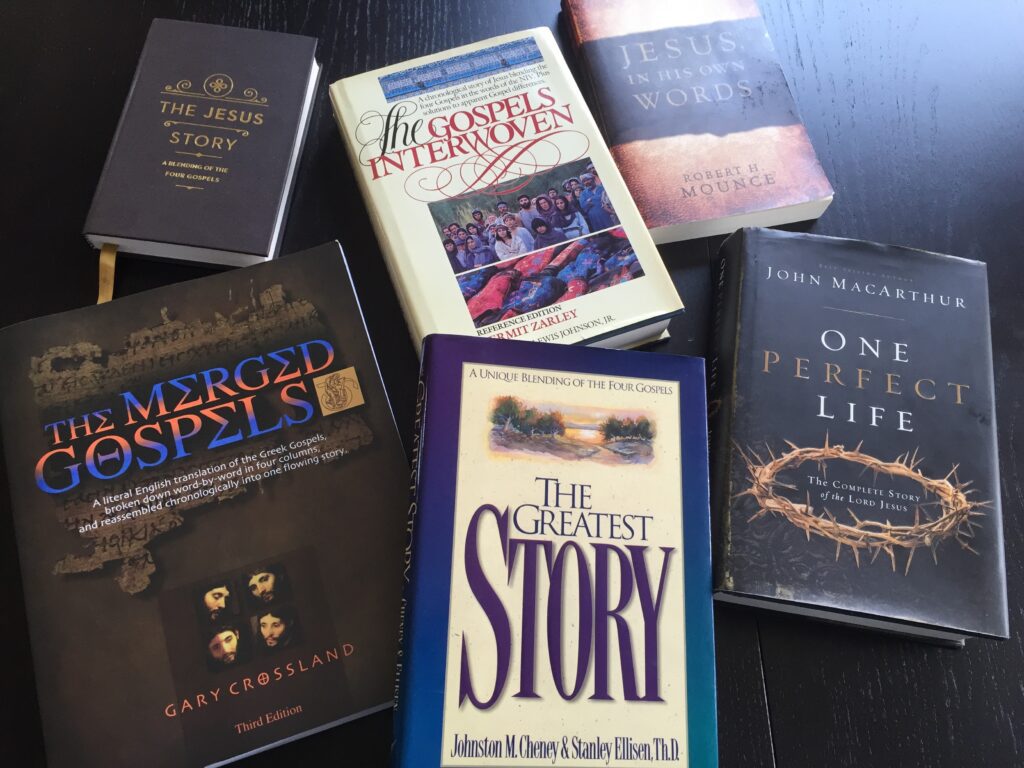Dive into Jesus with a Harmony of the Gospels
Back in 2016 I decided to take a deep dive into Jesus, studying a different harmony of the Gospels every month throughout the year. In 2018, I did the same thing again, revisiting a few of my favorite harmonies from 2016 while studying through several new ones. In 2021, I plan on taking another deep dive into the life of Christ.
Ministry leaders who know of the journey I’ve taken through many different harmonies ask the obvious question, “Which harmony of the Gospels is the best for studying and understanding the chronology of the life and ministry of Christ? Which harmonies would you avoid?”
While I definitely have an opinion, I generally steer away from discussing the harmonies I would never study again, and focus on the few that I have found most beneficial.
So, if you want to take a deep dive into the life of Christ this summer, where should you begin?
THE HARMONY OF THE GOSPELS / THOMAS & GUNDRY
Let me start with Sonlife’s preferred resource, The Harmony of the Gospels by Thomas & Gundry. This harmony is based on the classic and widely accepted work of A.T. Robertson. It’s laid out in the side by side format so you can read the gospel texts comparatively in their entirety. Thomas and Gundry’s Harmony has section numbers, which Sonlife uses as reference points in our Strategy Seminar, Knowing Him study, Harmony Study, and Life of Christ Israel Study Tour. Also included are several scholarly essays in the appendix on the value, development, and chronological work done to create their harmony. One frustrating aspect of the harmony is that for some odd reason the NIV version of their resource and the NASB version use different numbering systems (Sonlife uses the NIV numbering of events).
At this point, The Harmony of the Gospels by Thomas & Gundry is not available in a digital format, but A.T. Robertson’s A Harmony of the Gospels for Students of the Life of Christ is in my digital library of ebooks.
HARMONIES IN MY LIBRARY
- The Life of Christ in Stereo by Johnston M. Chaney
- The Greatest Story by Cheney and Ellisen
- Jesus Christ: The Greatest Life by Cheney and Ellisen
- The Jesus Story compiled by Bill Perkins
- Jesus: In His Own Words by Robert Mounce
- One Perfect Life by John MacArthur
- The Gospel Interwoven by Kermit Zarley
- The Merged Gospels by Gary Crossland
- Eyewitness by Frank Ball
- Jesus: A Biblical Biography by Andrew Jackson
- A Simplified Harmony of the Gospels by George Knight
- Ariel’s Harmony of the Gospels by Arnold Fruchtenbaum
- Harmony of the Gospels by Craig Sather
- The Four in One Gospel of Jesus by Nikola Dimitrov
- The Chronological Word Truth Life Bible by Austin Tucker
- The Diatessaron by Tatian
- A Life Worth Knowing by David Barrett
- A Harmony of the Gospels by Loraine Boettner
- The Chronological Christ by James Hargreaves
- The Story of Jesus by Zondervan/NIV
- A Harmony of the Four Gospels by Orville Daniel
- A Harmony of the Gospels by Ralph Daniel Heim
- A Harmony of the Gospels for Historical Study by Stevens and Burton
- The Jesus Gospel by Gary Scarano
- The Ministry of Jesus by R.D. Meyers

I have used all but three of these harmonies for personal study on the life of Christ, and my TOP THREE after Thomas and Gundry are:
THE GREATEST STORY / CHENEY AND ELLISEN
The Greatest Story is an updated version of Johnston Cheney’s The Life of Christ in Stereo. It also serves as the basis for the workbook format, Jesus Christ: The Greatest Life as well as the narrative format, The Jesus Story. Before computers were available to compile a resource like this, Johnston Cheney translated the four Gospels from the Greek, laid them out side by side, and then wove them together into a single narrative. The Greatest Story updates the language used, making it more readable, but does not include the notes that show you exactly how the four Gospels are weaved into one story, which The Life of Christ in Stereo and Jesus Christ: The Greatest Life include for the more serious student. The first two versions of Cheney’s work, The Life of Christ in Stereo and The Greatest Life are no longer in print and can only be found as used books, but are well worth the search. A few uniquenesses of Cheney’s harmony study are that he advocates for an extra year in the ministry of Christ as opposed to the traditional three and a half year time period. He also takes an event like Peter’s denials of Christ and argues for six denials, two sets of three, as opposed to the traditional view of three denials. The Greatest Story reads well and has you seeing the life of Christ from a fresh perspective as you read it in story form.
JESUS, IN HIS OWN WORDS / ROBERT MOUNCE
Robert Mounce certainly brings well-established credentials to his harmony due to the fact that he served on the translation teams for the New International Version, the New Living Translation, and the English Standard Version. Mounce’s harmony also uses a single narrative format where he weaves all four Gospels into a single story (as opposed to the side-by-side format of Thomas and Gundry’s Harmony). He has done his own translation work to compile Jesus, In His Own Words, and perhaps the most unique feature about his harmony is that he writes from the first person perspective, as though Jesus were telling His own story. It’s a beautiful way to read the gospel story, and Mounce’s chronology lines up well with A.T. Robertson and Thomas and Gundry.
ONE PERFECT LIFE / JOHN MACARTHUR
MacArthur’s harmony came out around the time I was beginning my journey through assorted harmonies and is one that I’ve gone back through a few times. A unique feature in One Perfect Life is the first and last section of the harmony, where MacArthur begins by weaving Old Testament passages together to demonstrate how Jesus fits into the history of the Bible and is the fulfillment of Messianic prophecy. He then closes out the harmony by weaving together passages from the New Testament Epistles to show the depth and riches of the theological teaching of the life of Christ. MacArthur’s work also weaves the four Gospels into a single narrative, with a coding system so you can see which Gospel phrases or verses are taken from. Unlike Mounce and Cheney though, MarArthur doesn’t translate directly from the Greek, but rather uses the New King James Version as the basis for his compilation. As an added benefit, notes from MacArthur’s commentaries on the Gospels are included for additional insight and study help. One Perfect Life also seems to line up closely with A.T. Robertson’s classic harmony work, making it a great complement to Thomas and Gundry’s side-by-side harmony.
A FEW QUESTIONS ABOUT USING A HARMONY OF THE GOSPELS
- Why read a Harmony of the Gospels as opposed to each Gospel separately? If they were meant to be read harmoniously, wouldn’t God have given them to us that way?
Each Gospel was written for a specific purpose to a specific audience. It appears that only Luke, the historian, set out to purposely give us an “orderly account” of the life of Christ. We should read each Gospel individually to understand the specific context and message for the audience that Gospel was originally intended for. At the same time, though, we should read all four Gospels collectively to grasp the fuller picture of the life and ministry of Christ. Aside from the events surrounding His crucifixion, the Feeding of the 5000 is the only event recorded in all four Gospels. So if we want a full picture of the life and ministry of Jesus, we need to consider the story through the lens of all four Gospel writers together. So then the question becomes…
- What is the value in looking at the life of Christ from a chronological perspective?
First, I would ask, why wouldn’t we want to look at the life of Christ from a chronological perspective? Doesn’t looking at the chronology help us to understand the life of Christ within its historical context? And are there lessons to be learned from the life of Christ as it is understood in its chronological context? What did Jesus do in year one, year two and year three? Are there principles at work behind the choices Jesus made, and when He made them? Is there any significance to the ministry priorities Jesus established and the leadership principles He practiced to build an enduring disciple-making movement?
- How do we know which harmony gets it right?
No harmony of the Gospels is perfect. While we believe in the inerrancy of Scripture, we also recognize that arranging the four Gospels in a chronological order is a scholarly effort that no one compiler’s work can claim to be divinely inspired. As a matter of principle, we would view harmonies that rely more heavily upon Luke’s Gospel with its “orderly account” as well as John’s Gospel that is built around the Jewish Feasts as the most accurate chronologies. Sometimes, there is a matter of preference involved in the laying out of a harmony. As an example, some choose to start with Matthew’s genealogy while others prefer John’s theological backdrop of Jesus as “the Word made flesh.” Still others would begin with Luke’s introduction to Theophilus on the purpose of writing his orderly account. Some might even choose Mark’s introduction: The beginning of the good news about Jesus the Messiah, the Son of God. Which of these four introductions a harmony chooses to start with is not a matter of chronology as much as it is a reflection of the compiler’s style and preference. While it’s not perfect, A.T. Robertson’s work has been considered a solid, reliable harmony for almost a century and serves as the basis for the work of many other harmony of the Gospels compilers.
The greatest advantage I have found to studying the life of Christ by using a harmony of the Gospels, in addition to studying each Gospel individually, is that I am studying the life of Christ! I am taking a deep dive into Jesus, and by doing so, I am giving the Holy Spirit the opportunity to do exactly what Jesus had promised He would do. Teach me about the Son’s life. I am falling more and more in love with Jesus as He has revealed Himself to us in the Scriptures.
“But when the Father sends the Advocate as My representative- that is, the Holy Spirit- He will teach you everything and will remind you of everything I have told you.”
John 14:26
